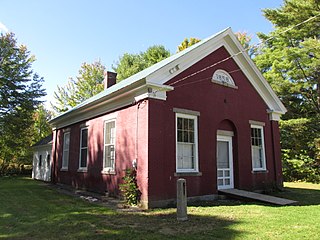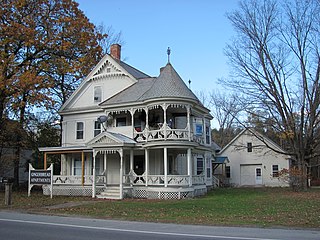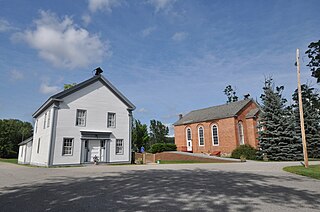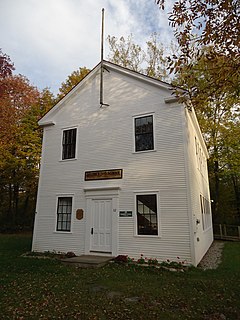
Sanborn Seminary is a historic educational facility in Kingston, New Hampshire. Its main building was built in 1883 by Major Edward S. Sanborn to serve as a secular secondary boarding school. The school ran continuously until 1966 when it was sold to the Town of Kingston. The campus became known as Sanborn Regional High School and served students from the towns of Kingston, Newton, and Fremont. The last class at this campus graduated in June 2006.

Christ Church is a historic church located at Melendy Hill Road and US Route 5 in Guilford, Vermont. Built in 1817 and later given Gothic Revival styling, it was the first Episcopal Church in Vermont. On May 13, 1982, it was added to the National Register of Historic Places. It is now owned by the Episcopal Diocese of Vermont and maintained by a local nonprofit organization.

The Cambridge Meetinghouse, also known locally as the Old Brick Church is a historic meetinghouse at 85 Church Street in Jeffersonville, the main village of Cambridge, Vermont. Built in 1826 as a union church for several denominations, it began use as the local town hall in 1866, a use that continued to 1958. It was listed on the National Register of Historic Places in 1981. It presently houses the local post office.

The Holland Congregational Church is a historic church on Gore Road in Holland, Vermont. Built in 1844, it is a prominent local example of Greek Revival architecture, and is the town's only surviving 19th-century public building. It was listed on the National Register of Historic Places in 1986.

The Dry Mills Schoolhouse is a historic schoolhouse on Game Farm Road in Gray, Maine. Built about 1857, it is the town's last surviving single-room district schoolhouse, and is now a local museum. The building was added to the National Register of Historic Places listings on December 13, 1996.

The District No. 2 Schoolhouse, also known as the Little Red Schoolhouse, is a historic one-room schoolhouse at 2851 Wakefield Road in Wakefield, New Hampshire. Built in 1858–59, it was at the time one of the finest district schoolhouses in rural New Hampshire. It was used as a school until 1941, and now houses the museum of the local historical society. The building was listed on the National Register of Historic Places in 1980.

The Grafton District Schoolhouse No. 2, also known locally as the Old Fire Station, is a historic civic building at 217 Main Street in Grafton, Vermont. Built about 1835, it has served as a school, fire station, Masonic hall, tin shop, undertaker's shop, and as the clubhouse of a local brass band. Despite some alteration, it is a well-preserved example of a mid-19th century Greek Revival schoolhouse. It was listed on the National Register of Historic Places in 2005.

The Colburn School is a historic schoolhouse on Arnold Road in Pittston, Maine. With an estimated construction date of 1815, this brick schoolhouse is the best-preserved of the town's 19th-century district schools, and served for a time as the town hall. Now a local historical society museum, it was listed on the National Register of Historic Places in 2001.

The Watkins School is a historic school building at 26 Watkins Street in Rutland, Vermont. Built in 1897, it is a high quality local example of Colonial Revival architecture, and a fine example of a period graded school. It was listed on the National Register of Historic Places in 2014. It has been converted to residential use.

The Greenwood House, now the Gingerbread Apartments, is a historic house on Vermont Route 103 in Chester, Vermont. Built about 1850 and restyled about 1900, it is an architecturally distinctive blend of Greek Revival and Late Victorian styles. It was listed on the National Register of Historic Places in 1985.

The Ludlow Graded School is a historic former school building at 10 High Street in the village of Ludlow, Vermont. Built in 1871-72, the school was for many years the primary school feeding the adjacent Black River Academy. The building now serves as a local senior services center. It was listed on the National Register of Historic Places in 1979.

The School House and Town Hall is a historic municipal building on Schoolhouse Road, just west of United States Route 7 in the center of Leicester, Vermont. Built about 1858, it is a fine example of late Greek Revival architecture, and is the town's best-preserved district schoolhouse. Its upper floor has served as the town hall since its construction. It was listed on the National Register of Historic Places in 1988.

Salisbury Town Hall is a historic municipal building at Maple and Prospect streets in Salisbury, Vermont. Built in 1869, it is a fine local example of Greek Revival architecture, and has served the rural community in a variety of ways: as town hall, library, and as educational facility. It was listed on the National Register of Historic Places in 1995.

The Newbury Town House is a historic government building on Scotch Hollow Road in Newbury, Vermont. Built in 1839, it is a well-preserved and little-altered example of an early Greek Revival town hall. It was listed on the National Register of Historic Places in 1983. While no longer used for town meetings, it is still owned by the town and used for other civic purposes, included elections.

Stratton's Inn is a historic house on East Street in Brookfield, Vermont. Built in the late 1790s as a tavern located at the junction of two locally important roads, it is a fine example of Federal period architecture, most importantly preserving the inn's original tap room. It was listed on the National Register of Historic Places in 1982.

The Richford Primary School is a historic school building at 140 Intervale Avenue in Richford, Vermont. Built in 1903 to address an overcrowding problem in the local schools, it served the town until 1968, and has since been converted into residential use. It was listed on the National Register of Historic Places in 2004.

The South Stone School House is a historic school building at Main Street and Quarry Road in Isle La Motte, Vermont. Built in 1843, it served the town as a district school until 1932, and has served as home to its historical society since then. It was probably built by James Ritchie, a noted local Scottish immigrant mason, and was listed on the National Register of Historic Places in 1997.

The Cobb School is a historic district schoolhouse at Cobb School Road and Bridgman Hill Road in Hardwick, Vermont. Built in the 1840s, it is a well-preserved example of a Greek Revival district school building. It served as a school until 1946, aided by modernization steps taken in the early 20th century to maintain state standards. It was listed on the National Register of Historic Places in 1993.

The Peoples Academy is a historic high school in Morrisville, Vermont.

The District No. 5 Schoolhouse is a historic district school building at 32 Pleasant Valley Road in Underhill, Vermont. Built in 1861, it served the town as a school until it was damaged by fire in 1951, but remains a community landmark. It is now owned by the local historical society. It was listed on the National Register of Historic Places in 2018.























